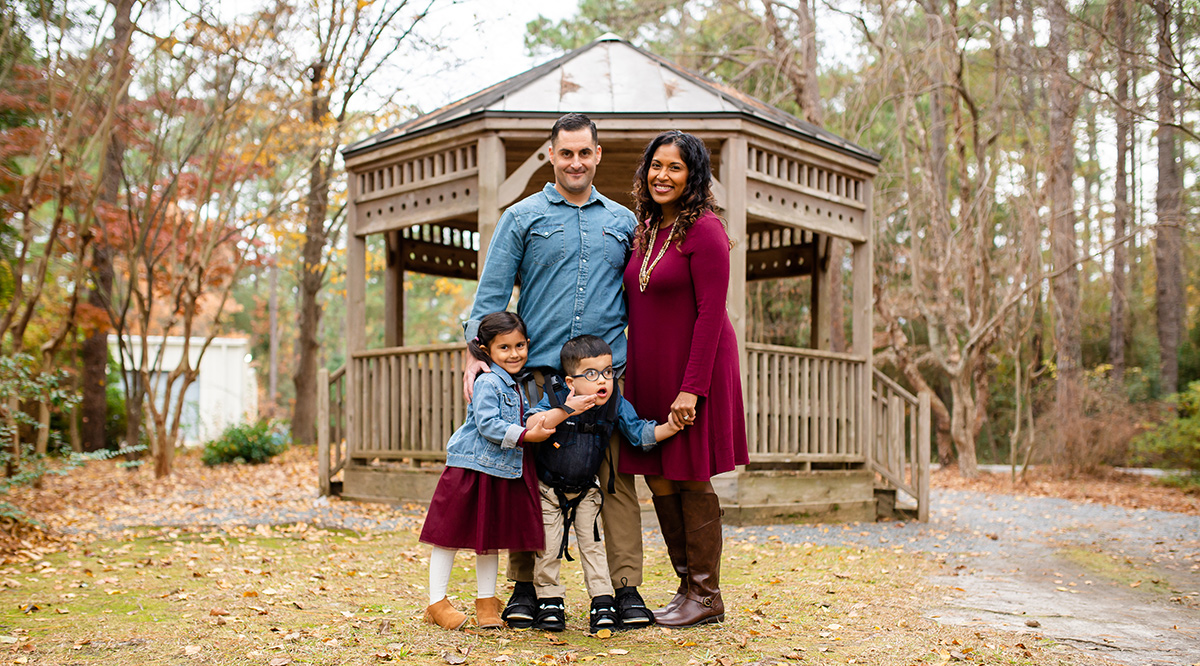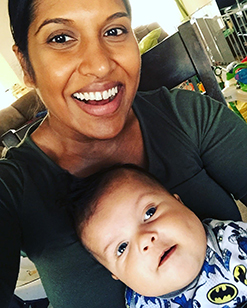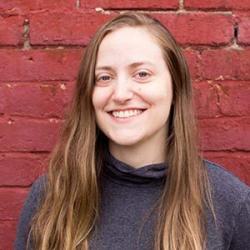
Nazira Kelly first noticed something was different about her newborn son, Ezra, when he was two weeks old. While many newborns develop splotchy red rashes that go away after a few days or weeks, Ezra’s skin had an unusual, swirling pigmentation. Then, when Ezra was about four weeks old, Kelly noticed that his head had grown unusually large, and he was having trouble lifting it.
A registered nurse who worked in the Labor and Delivery unit, Kelly immediately brought her concerns to his pediatrician. But a head ultrasound came back normal, and the dermatologist recommended he see a neurologist, who advised the Kellys to track Ezra’s head growth and other symptoms.
Kelly held onto hope that maybe these unusual symptoms would sort themselves out. Then, when Ezra was six months old, Kelly awoke at 5:30 a.m. to see her baby having a seizure.
“Our lives just changed right there,” she says.
Ezra was put through two rounds of genetic testing, but his condition eluded the geneticist. Over the next three months, Ezra had two more seizures — but no clear diagnosis.
Around this time, the family moved from Kansas to North Carolina and set Ezra up with a new slate of specialists. It was their neurologist at Duke University Medical Center in Durham who suggested they apply to the Undiagnosed Diseases Network (UDN), a consortium of 12 academic medical centers across the country funded by the National Institutes of Health (NIH) and dedicated to combining expertise, technology, and shared data to try to solve the most challenging medical mysteries. Duke happened to be one of the network’s clinical sites.
About three months after being accepted to the program, the UDN team at Duke had cracked the case. Ezra had a rare genetic disorder called Smith-Kingsmore syndrome caused by changes to the MTOR gene, which plays an essential role in cell growth and function. Only about 10 in 10,000 individuals are affected by MTOR disorders.
Although there is no cure or treatment, Kelly was relieved to finally have some answers.
“In the beginning, the ocean is so vast, you don’t know what to ask or where to go for information,” Kelly says. “The UDN really streamlined everything.”
Since its inception in 2014, the UDN has reviewed more than 5,800 applications, accepted more than 2,300 participants, and discovered 50 new conditions. It’s done so by bringing together a multidisciplinary team of specialists and researchers and using innovative diagnostic technologies.

“The UDN has seen extensive collaborations develop between clinicians and researchers. That doesn’t typically happen in a clinical setting,” says Kimberly LeBlanc, MS, a genetic counselor and director of the UDN Coordinating Center at Harvard Medical School. “It’s been amazing to see all of these different clinicians and researchers come together to try to help undiagnosed patients.”
The UDN will likely operate differently in coming years, however, as NIH funding for the network — which was always intended to launch, rather than sustain, the program — will sunset in June 2023.
And while the funding mechanisms and organization may change, the investigators and scientists who have pioneered the network’s advancement are determined to continue to build on the UDN’s success.
“I don’t think there’s any doubt that the UDN will continue,” says Vandana Shashi, MD, a pediatrician and principal investigator of the UDN clinical site at Duke. “We’re all committed to doing this work.”
Advancing diagnostic technologies
One key to the success of the UDN is its focus on leveraging cutting-edge genetic analysis and modeling, explains Brendan Lee, MD, PhD, who chairs the Department of Molecular and Human Genetics and is director of the Undiagnosed Diseases Center at Baylor College of Medicine in Houston, Texas.
While genomic sequencing has been around for decades, laboratories involved in the UDN have advanced genetic analysis capabilities, including “multi-omic” approaches that map out not only the patient’s DNA but also the molecules responsible for protein-coding and for metabolic function. They can also analyze RNA, which carries genetic information, informs gene expression, and translates different proteins into essential functions. Mapping out the patient’s genes with these functionalizing approaches can help to identify the disease-causing variants with more precision and sensitivity that more basic sequencing might overlook.
“Sometimes things that are cryptic then become very obvious when we look directly at the RNA,” says Stanley Nelson, MD, a pediatrician specializing in rare diseases and the principal investigator of the UDN clinical site at the University of California, Los Angeles David Geffen School of Medicine.
Baylor serves as the UDN’s sequencing core, aiding the 12 clinical sites in the advanced genetic analyses needed to pinpoint more specific variations in the patients’ genes. It also hosts one of the network’s two model organism screening centers, where researchers test human genetic variations in animal models — specifically fruit flies, worms, and zebrafish — to see how the variation may or may not contribute to disease presentation.
Depending on whether the disease-causing variants have been observed previously, diagnosis can take anywhere from weeks to years, with the UDN successfully diagnosing about 30% of the patients accepted to the program.
But the UDN never “closes” an undiagnosed case, says Shashi. Rather, it stores all its data analysis at the coordinating center at Harvard and maintains biological samples at the UDN biorepository at Vanderbilt University Medical Center in Nashville.
“This allows us to do ongoing research into diagnoses for patients,” LeBlanc says.
So as technology advances or if new patients accepted to the network shed further light on specific conditions, the UDN may be able to solve old cases with new information.
Meeting of the minds
The other key to the UDN’s work is its multidisciplinary, collaborative approach to each case. Once all necessary testing has been done, experts from a variety of specialties and across multiple institutions get on a call together to discuss — and sometimes debate — potential diagnoses.
“Many times, people go to a specialist and they receive care for their heart, but not their kidney,” says Nicola Longo, MD, PhD, chief of the Division of Medical Genetics at the University of Utah School of Medicine, which is one of the UDN’s clinical sites. “The nice thing about having a team of people is that if you have an immunological condition, we have an immunologist. If you have a kidney condition, we have a nephrologist. If you have an intestinal condition, we have a gastroenterologist. … The capacity of having multiple specialists talking together and having a general practitioner — or a geneticist, in our case — coordinating the care of multiple specialists will ensure that we are taking care of the patient, not of a specific organ.”
When managing a patient with complex needs, one issue that often hampers the patient’s diagnosis and care is a lack of communication among medical professionals, Lee says. Furthermore, each physician — across multiple specialties, and even within the same specialty — brings a distinct perspective to the case. Bringing these minds together to study cases in real time multiplies the chances of a successful diagnosis, he says.
“The collaboration component is so key,” Lee says. “There is a maximum increase in productivity, efficiency, and brainpower.”
At times, bringing together specialists from different institutions has also helped to connect the dots for extremely rare conditions by identifying multiple patients with the same or similar conditions.
“It’s a repository of clinical knowledge,” Nelson says, explaining that he had just completed a weekly UDN call where researchers from the clinical site at the University of Washington in Seattle had presented a case that was reminiscent of a UCLA case on which Nelson was the lead clinician. Both cases involved a previously healthy teenager who suddenly began to develop abnormal movements, trouble swallowing, and difficulty finding words. Though there hasn’t been a solution for either case, now the UDN can examine the cases jointly.
“We can start to join these cases together to make small cohorts,” Nelson says.
Diagnosis as hope
For Kelly, being able to put a name to Ezra’s condition has been life changing. After receiving the Smith-Kingsmore syndrome diagnosis, Kelly promptly Googled the condition and found a support group on Facebook. She soon became involved with the Smith-Kingsmore Syndrome Foundation and attended a conference where she was able to connect with other families of people with the condition.
When you don’t have a diagnosis, “you really just feel lost, and it’s lonely,” Kelly says. “Seeing these other kids [who] looked like your child physically, [I thought,] ‘These people get me.’ They understood the frustration and feelings, the tears. That was exactly how I felt, those are the same things we went through. It was like finding a lost family member.”
Kelly’s experience is not unique.
Shashi says that her patients who receive a diagnosis for themselves or a family member often feel immense relief, even without an available treatment, especially since the diagnosis allows them to connect with others who have the same condition.
“I don’t think anybody understands how hard it is to live without having a diagnosis,” she says. “We will never have a treatment if we don’t know what’s wrong. … As one patient put it to me, ‘For me, the diagnosis is hope.’”
Many patients and their families start or join foundations and advocate for research and funding, Shashi says.
Through the Smith-Kingsmore Syndrome Foundation, Kelly has helped fundraise for a postdoctoral candidate who is studying the syndrome. She doesn’t expect these efforts will pay off in time to benefit Ezra, but she hopes that today’s work could help children diagnosed in the future.
And this is both a great challenge and a great potential for the work the UDN does. Most of the conditions it identifies don’t have known treatments or cures. Though occasionally physicians can recommend a therapy approved by the Food and Drug Administration or connect patients with a clinical trial, more often the diagnoses are only laying the foundation for further research into treatments, says Nelson.
“It’s not as satisfying as any of us would like,” he says.
Still, he believes the UDN’s progress has been accelerating in recent years.
Continuing the mission
The UDN was formed using money from the NIH’s Common Fund, a mechanism intended for “short-term, goal-driven strategic investments,” according to its website. Although consistent NIH funding for the network will sunset next year, the NIH will continue to fund certain aspects, such as a coordinating center, through grants. The intent is to replace the UDN with a network of Diagnostic Centers of Excellence that can be sustained through different funding mechanisms, LeBlanc explains.
Four of the 12 clinical sites have paused reviewing applications for new patients, according to the UDN website. The UDN has committed to continue to analyze data for existing patients and is still reviewing all applications. Several of the clinical sites are pursuing alternative funding sources, such as institutional funding, philanthropy, and grants, in order to continue and expand on the work that the UDN facilitated.
“I think all of the parts of UDN need to adapt to the reality and every site will have a different solution,” Lee says. “We are committed to this. … We were doing it before the UDN, and we will do it in the new version of the UDN.”
LeBlanc says that the coordinating center is supporting the startup of a foundation to have sustainable funding and oversight for the initiative, and Lee says he expects academic institutions will dedicate funding for the work.
“The major medical centers that are engaged in gene discovery are the medical centers where people want to bring their children and their adult relatives [with undiagnosed conditions],” Nelson adds.
“This is such an important enterprise; [discovering] what are the genes that contribute to meaningful diseases in humans. … It’s a very natural integration of what our academic medical centers do well.”
